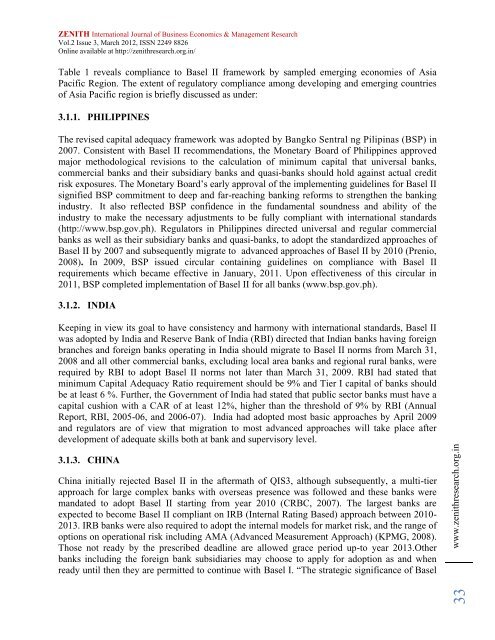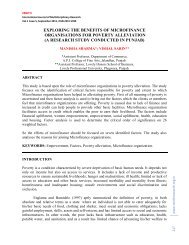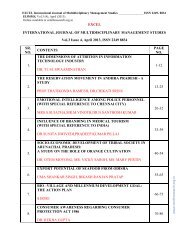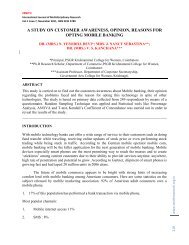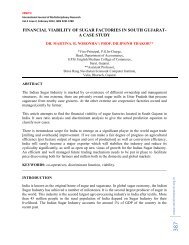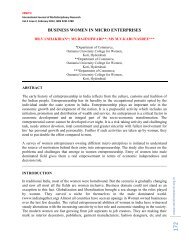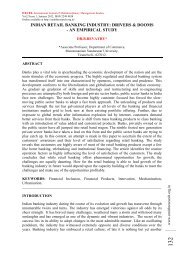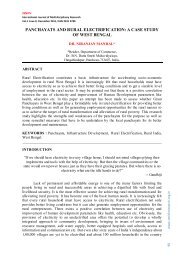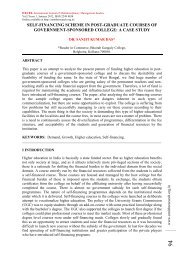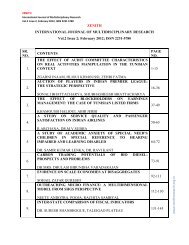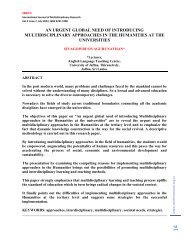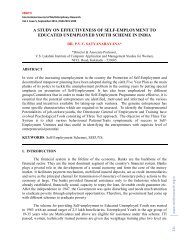ZIJBEMR MARCH 2012 ISSUE COMPLETE.pdf - zenith ...
ZIJBEMR MARCH 2012 ISSUE COMPLETE.pdf - zenith ...
ZIJBEMR MARCH 2012 ISSUE COMPLETE.pdf - zenith ...
You also want an ePaper? Increase the reach of your titles
YUMPU automatically turns print PDFs into web optimized ePapers that Google loves.
33www.<strong>zenith</strong>research.org.inZENITH International Journal of Business Economics & Management ResearchVol.2 Issue 3, March <strong>2012</strong>, ISSN 2249 8826Online available at http://<strong>zenith</strong>research.org.in/Table 1 reveals compliance to Basel II framework by sampled emerging economies of AsiaPacific Region. The extent of regulatory compliance among developing and emerging countriesof Asia Pacific region is briefly discussed as under:3.1.1. PHILIPPINESThe revised capital adequacy framework was adopted by Bangko Sentral ng Pilipinas (BSP) in2007. Consistent with Basel II recommendations, the Monetary Board of Philippines approvedmajor methodological revisions to the calculation of minimum capital that universal banks,commercial banks and their subsidiary banks and quasi-banks should hold against actual creditrisk exposures. The Monetary Board’s early approval of the implementing guidelines for Basel IIsignified BSP commitment to deep and far-reaching banking reforms to strengthen the bankingindustry. It also reflected BSP confidence in the fundamental soundness and ability of theindustry to make the necessary adjustments to be fully compliant with international standards(http://www.bsp.gov.ph). Regulators in Philippines directed universal and regular commercialbanks as well as their subsidiary banks and quasi-banks, to adopt the standardized approaches ofBasel II by 2007 and subsequently migrate to advanced approaches of Basel II by 2010 (Prenio,2008). In 2009, BSP issued circular containing guidelines on compliance with Basel IIrequirements which became effective in January, 2011. Upon effectiveness of this circular in2011, BSP completed implementation of Basel II for all banks (www.bsp.gov.ph).3.1.2. INDIAKeeping in view its goal to have consistency and harmony with international standards, Basel IIwas adopted by India and Reserve Bank of India (RBI) directed that Indian banks having foreignbranches and foreign banks operating in India should migrate to Basel II norms from March 31,2008 and all other commercial banks, excluding local area banks and regional rural banks, wererequired by RBI to adopt Basel II norms not later than March 31, 2009. RBI had stated thatminimum Capital Adequacy Ratio requirement should be 9% and Tier I capital of banks shouldbe at least 6 %. Further, the Government of India had stated that public sector banks must have acapital cushion with a CAR of at least 12%, higher than the threshold of 9% by RBI (AnnualReport, RBI, 2005-06, and 2006-07). India had adopted most basic approaches by April 2009and regulators are of view that migration to most advanced approaches will take place afterdevelopment of adequate skills both at bank and supervisory level.3.1.3. CHINAChina initially rejected Basel II in the aftermath of QIS3, although subsequently, a multi-tierapproach for large complex banks with overseas presence was followed and these banks weremandated to adopt Basel II starting from year 2010 (CRBC, 2007). The largest banks areexpected to become Basel II compliant on IRB (Internal Rating Based) approach between 2010-2013. IRB banks were also required to adopt the internal models for market risk, and the range ofoptions on operational risk including AMA (Advanced Measurement Approach) (KPMG, 2008).Those not ready by the prescribed deadline are allowed grace period up-to year 2013.Otherbanks including the foreign bank subsidiaries may choose to apply for adoption as and whenready until then they are permitted to continue with Basel I. “The strategic significance of Basel


